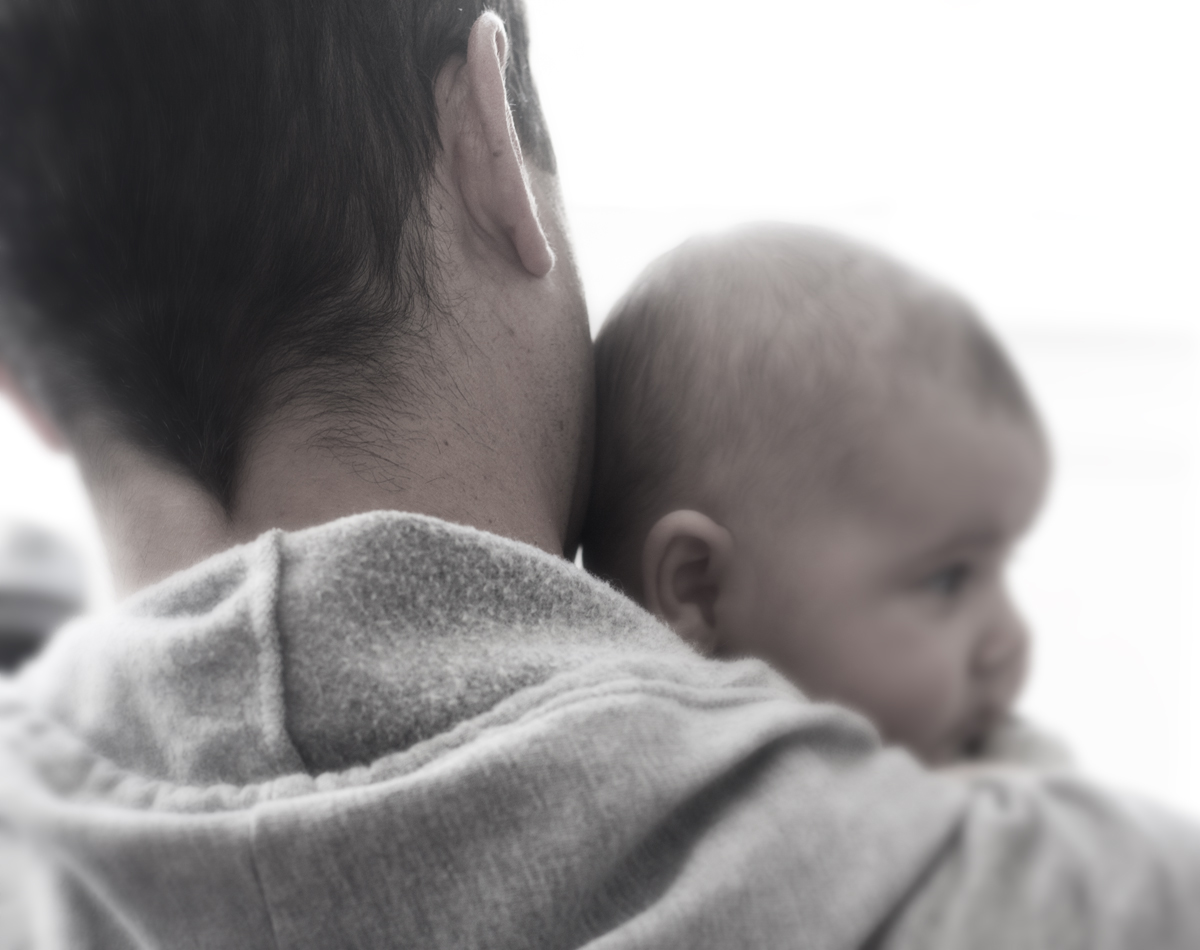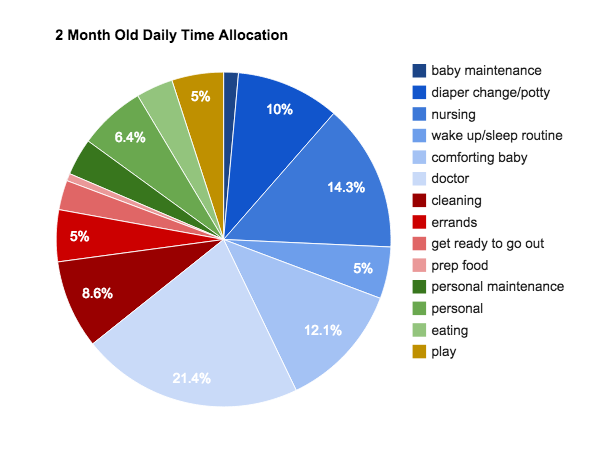I thought it might be interesting to do this report on what stay-at-home parents do all day. The trouble with being a stay at home parent is that you often look at the clock and it’s 5pm and you have absolutely no idea how that happened and what were you doing all day, and lord knows it wasn’t sitting down for any stretch of time or eating anything. Where did all that time just go?
So, I asked a few of my friends with children of different ages to keep a time journal for a typical day. What do we do all day? Not only would we answer this question for ourselves, but I thought it might be informative for people who aren’t yet parents, or for women who are approaching maternity leave, to get a sense of what it looks like to take care of a baby all day.
(Now, I cut off their time journals from the time husbands went to work and husbands returned home. There’s some debate as to whether that’s fair or accurate — the work continues even after all parents are home. But, I didn’t want to include “the second shift” because this is something all parents deal with, whether they work out of the home, work in the home, or stay at home. I purely wanted a snapshot of a stay at home parent, when he or she is alone all day with their children.)
Today, I bring you a mother of a two month old aka the 4th trimester aka maternity leave. Her child isn’t terribly excited about doing things like taking naps or sleeping. He likes being held, like many newborns. She said this was a typical day (newborns have to go to the doctor a lot), but this was her third attempt at keeping a journal. It was a struggle for her to find the time to write down how long things were taking.
Like most of us, she imagined she’d have time to get some extracurricular hobbies done while on leave. I thought I’d be able to maintain this site and keep writing travel articles for other sites all easy peasy — “once I get a nap schedule down, I’ll be right back at it.”
Really, how much time could a baby take? And don’t they sleep a lot at this stage? Aren’t they just snuggly loafs at 2 months?
Since it is hard enough for you to remember what happened all day, it is also hard to explain to new parents why they won’t have time for anything other than tending to a newborn. By asking someone in the middle of the 4th trimester to explain her day, I’m hoping this will shed some light on what a typical day of maternity leave looks like.
Let’s take a look at how my friend spends a typical day:
I’ve categorized each of her activities into 4 color codes. Blue is the time she spends actively tending to the baby, red is the time that she spends dealing with household tasks, green is time she has for herself, and yellow is time she spends playing with her child.
Not surprisingly, blue takes up the vast majority of her day. She spends 11.67 hours alone with her child every day. Sixty-four percent of that time, she is actively tending to the child, or roughly 7.5 hours a day. Also surprising to most people, she nurses for nearly 2 hours a day, just while her husband is at work. Feeding a newborn takes a long time.
One of the other shocks of maternity leave is that not only are you now taking care of a baby for 7.5 hours a day, you’re now in charge of all housework. Living the June Cleaver dream. This friend spends an additional 2 hours running errands and tending to the home, every day. I should explain that one category “get ready to go out” — the three of us all had these large chunks of time in our days where we were really just gathering things in preparation to leave our apartments. I couldn’t figure out any other appropriate category for it. It just takes a long time to pack up diaper bags, gather shopping bags, haul strollers down steps, etc.
Then we have the green slices for herself. Half of her me-time is spent eating and brushing her teeth. In her 11-hour day, she rounded up 45 minutes to do something that was purely for herself. She actually (impressively!) did spend it doing some personal side-work. But, this 45 minutes wasn’t all in one go. This is why hobbies don’t really happen on maternity leave.
Then, finally, we have the tiny yellow sliver aka fun times with your baby. I lived through it and it’s still surprising to see. Between nursing and changing diapers and putting babies down for naps, repeat repeat repeat, there is practically no time for enjoying each other’s company. The image you have of a mother smiling at her newborn and kissing chiclet toesies…that is the few moments of calm in an otherwise whirlwind of a day.
The three of us have been discussing over email how the reality of these pie charts diverged from our expectations. I expected there would have been more green and yellow time, far less blue time, and red time didn’t register in my head at all. More playing and snuggling with baby, more time to myself during naps. Isn’t that what we all think? The hazy beautiful maternity leave days of snuggling and kissing.
How about you? Does this pie chart resonate? Or do you feel like your time was spent differently? Every baby is different of course, and every parent is different. It’d be fascinating to hear from others who’ve been through it.









AndyCow
You’re telling me she sleeps on average 5% of the time, and is at the doctors 21.5% of the time?
So she sleeps on average 1.2 hours a day for 2 months, and she’s at the doctor 5 hours a day? Your data doesn’t make sense.
5/11/2016 at 8:29 pm
Maria
Hi!
Let me clear up where we seem to be at odds. First, this isn’t a time study done over the course of a 24 hour period. As I explain in the write up, the time study was done over the course of 11.67 hours. My intent was to show what a woman on maternity leave does during the day — as in the chunk of time (roughly 7am to 7pm in this case) where she is alone with her child. I’m sure she slept at night, to the extent that she could.
The 5% refers to the time it takes for the mother to put her newborn to sleep or help the newborn wake up. This takes up roughly 0.58 hours, or about 35 minutes, in aggregate, over the course of her day. (Your calculation of 1.2 hours is assuming a 24 hour time period; it was actually only 0.58 hours.) This time study only focuses on what the mother did during the day, not what her baby was doing, and she didn’t sleep during the day, so I haven’t allotted a variable for sleep.
On this day, she had a doctor’s appointment. It took her roughly an hour to get to the appointment, and an hour to return (which is about what it would take me to get myself and my kid to a doctor’s appointment on Muni, so not abnormal in SF for those without cars), in addition to time spent in the waiting room and time spent with an actual doctor. Mothers end up taking newborns in for check ups (for themselves and their newborns) fairly frequently in the early months, and so it’s not too odd that the doctor’s appointment happened on this day.
Finally, this was just one randomly selected day in her life, not a series of time studies done over the course of days or weeks or months. So, to say she spent 2.5 hours/day (I believe you calculated 5 hours/day assuming this was a 24 hour period, but as I explained in the post, this was only an 11.67 hour period, so it’s actually 2.5 hours) at the doctor isn’t accurate — she spent 2.5 hours on this one day going to/seeing/coming back from the doctor’s office.
Does that make sense?
5/11/2016 at 9:32 pm